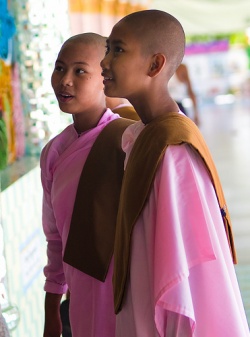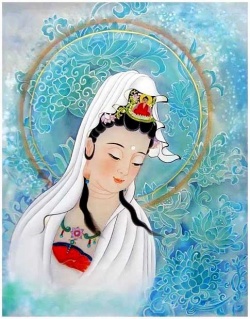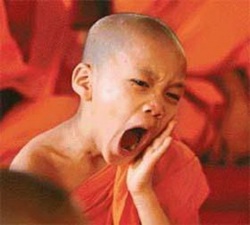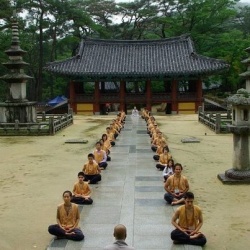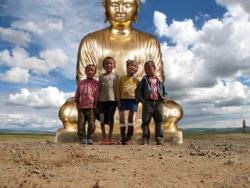Hinduism And Buddhism
Book III - Pali Buddhism . . Chapter XIII - The Canon
. . . Part 3
Lines of growth are clearly discernible in the Vinaya and Sutta Pitakas. As already mentioned, the Khuddaka-Nikâya is, as a collection, later than the others although separate books of it, such as the Sutta-nipâta (especially the fourth and fifth books), are among the earliest documents which we possess.
But other books such as the Peta-[1] and Vimâna-vatthu show a distinct difference in tone and are probably separated from the Buddha by several centuries. Of the other four Nikâyas the Saṃyutta and Anguttara are the more modern and the Anguttara mentions Munda, King of Magadha who began to reign about forty years after the Buddha's death. But even in the two older collections, the Dîgha and the Majjhima, we have not reached the lowest stratum.
The first thirteen suttantas of the Dîgha all contain a very ancient tractate on morality, and the Sâmaññaphala and following sections of the Dîgha and also some suttas of the Majjhima contain either in whole or in part a treatise on progress in the holy life. These treatises were probably current as separate portions for recitation before the suttas in which they are now set were composed.
Similarly, the Vinaya clearly presupposes an old code in the form of a list of offences called the Pâtimokkha. The Mahâvagga contains a portion of an ancient word-for-word explanation of this code[2] and most of the Sutta-vibhanga is an amplification and exposition of it.
The Pâtimokkha was already in existence when these books were composed, for we hear[3] that if in a company of Bhikkhus no one knows the Pâtimokkha, one of the younger brethren should be sent to some better instructed monastery to learn it. And further we hear[4] that a learned Bhikkhu was expected to know not merely the precepts of the Pâtimokkha but also the occasion when each was formulated. The place, the circumstances and the people concerned had been in each case handed down. There is here all the material for a narrative.
The reciter of a sutta simply adopts the style of a village story-teller.
"Thus have I heard. Once upon a time the Lord was dwelling at Râjagaha,"
or wherever it was, and such and such people came to see him. And then, after a more or less dramatic introduction, comes the Lord's discourse and at the end an epilogue saying how the hearers were edified and, if previously unconverted, took refuge in the true doctrine.
The Cullavagga states that the Vinaya (but not the other Pitakas) was recited and verified at the Council of Vesâlî. As I have mentioned elsewhere, Sinhalese and Chinese accounts speak of another Council, the Mahâsangha or Mahâsangîti. Though its date is uncertain, there is a consensus of tradition to the effect that it recognized a canon of its own, different from our Pali Canon and containing a larger amount of popular matter.
Sinhalese tradition states that the canon as we now have it was fixed at the third Council held at Pataliputra in the reign of Asoka (about 272-232 B.C.). The most precise statements about this Council are those of Buddhaghosa who says that an assembly of monks who knew the three Pitakas by heart recited the Vinaya and the Dhamma.
But the most important and interesting evidence as to the existence of Buddhist scriptures in the third century B.C. is afforded by the Bhâbrû (or Bhâbrâ) edict of Asoka. He recommends the clergy to study seven passages, of which nearly all can be identified in our present edition of the Pitakas[5]. This edict does not prove that Asoka had before him in the form which we know the Dîgha and other works cited. But the most cautious logic must admit that there was a collection of the Buddha's sayings to which he could appeal and that if most of his references to this collection can be identified in our Pitakas, then the major part of these Pitakas is probably identical in substance (not necessarily verbally) with the collection of sayings known to Asoka.
Neither Asoka nor the author of the Kathâ-vatthu cites books by name. The latter for instance quotes the well-known lines "anupubbena medhavi" not as coming from the Dhammapada but as "spoken by the Lord." But the author of the Questions of Milinda, who knew the canonical books by the names they bear now, also often adopts a similar method of citation. Although this author's probable date is not earlier than our era his evidence is important. He mentions all five Nikâyas by name, the titles of many suttas and also the Vibhanga, Dhâtu-kathâ, Puggala-Paññatti, Kathâ-vatthu, Yamaka and Paṭṭhâna.
Everything indicates and nothing discredits the conclusion that this canon of the Vibhajjavâdins was substantially fixed in the time of Asoka, so far as the Vinaya and Sutta Pitakas are concerned. Some works of minor importance may have had an uncertain position and subsequent revisions may have been made but the principal scriptures were already recognized and contained passages which occur in our versions. On the other hand this recension of the scriptures was not the only one in existence. If the patronage of Asoka gave it a special prestige in his lifetime, it may have lost it in India after his death and for many centuries the Buddhist Canon, like the list of the Upanishads, must have been susceptible of alteration.
The Sarvâstivâdins compiled an Abhidhamma Pitaka of their own, apparently in the time of Kanishka, and the Dharmagupta school also seems to have had its own version of this Pitaka[6]. The date of the Pali Abhidhamma is very doubtful and I do not reject the hypothesis that it was composed in Ceylon, for the Sinhalese seem to have a special taste for such literature. But there is no proof of this Sinhalese origin.
According to Sinhalese tradition all three Pitakas were introduced into Ceylon by Mahinda in the reign of Asoka, but only as oral tradition and not in a written form. They received this latter about 20 B.C., as the result of a dispute between two monasteries[7]. The controversy is obscure but it appears that the ancient foundation called Mahâvihâra accepted as canonical the fifth book of the Vinaya called Parivâra, whereas it was rejected by the new monastery called Abhayagiri. The Sinhalese chronicle (Mahâvamsa XXXIII. 100-104) says somewhat abruptly
"The wise monks had hitherto handed down the text of the three Pitakas (Piṭakattayapâlim) as well as the commentary by word of mouth. But seeing that mankind was becoming lost, they assembled together and wrote them in books in order that the faith might long endure."
This brief account seems to mean that a council was held not by the whole clergy of Ceylon but by the monks of the Mahâvihâra at which they committed to writing their own version of the canon including the Parivâra. This book forms an appendix to the Vinaya Pitaka and in some verses printed at the conclusion is said to be the work of one Dîpa. It is generally accepted as a relatively late production, composed in Ceylon. If such a work was included in the canon of the Mahâvihâra, we must admit the possibility that other portions of it may be Sinhalese and not Indian.
But still the onus probandi lies with those who maintain the Sinhalese origin of any part of the Pali Canon and two strong arguments support the Indian origin of the major part. First, many suttas not only show an intimate knowledge of ancient Indian customs but discuss topics such as caste, sacrifice, ancient heresies, and the value of the Veda which would be of no interest to Sinhalese. Secondly, there is no Sinhalese local colour and no Sinhalese legends have been introduced. Contrast with this the Dîpa-and Mahâ-vaṃsa both of which open with accounts of mythical visits paid by the Buddha to Ceylon[8].
In Ceylon versions of the scriptures other than that of the Mahâvihâra were current until the twelfth century when uniformity was enforced by Parâkrama Bâhu. Some of these, for instance the Pitaka of the Vetulyakas, were decidedly heretical according to the standard of local orthodoxy but others probably presented variations of reading and arrangement rather than of doctrine. Anesaki[9] has compared with the received Pali text a portion of the Saṃyuktâgama translated by Guṇabhadra into Chinese. He thinks that the original was the text used by the Abhayagiri monastery and brought to China by Fa Hsien.
The Sinhalese ecclesiastical history, Nikâya-Sangrahawa, relates[10] that 235 years after the Buddha's death nine heretical fraternities were formed who proceeded to compose scriptures of their own such as the Varṇapiṭaka and Angulimâla-Piṭaka. Though this treatise is late (c. 1400 A.D.) its statements merit attention as showing that even in orthodox Ceylon tradition regarded the authorized Pitaka as one of several versions. But many of the works mentioned sound like late tantric texts rather than compositions of the early heretics to whom they are attributed.
Ecclesiastical opinion in Ceylon after centuries of discussion ended by accepting the edition of the Mahâvihâra as the best, and we have no grounds for rejecting or suspecting this opinion. According to tradition Buddhaghosa was well versed in Sanskrit but deliberately preferred the southern canon. The Mahayanist doctor Asanga cites texts found in the Pali version, but not in the Sanskrit[11]. The monks of the Mahâvihâra were probably too indulgent in admitting late scholastic treatises, such as the Parivâra. On the other hand they often showed a critical instinct in rejecting legendary matter. Thus the Sanskrit Vinayas contain many more miraculous narratives than the Pali Vinaya.

